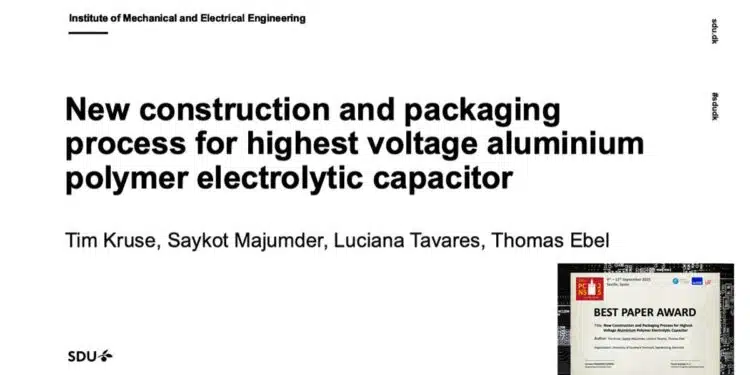The paper “New Construction And Packaging Process For Highest Voltage Aluminium Polymer Electrolytic Capacitor” was presented by Tim Kruse, Department of Mechanical and Electrical Engineering, University of Southern Denmark, Sønderborg, Denmark at the 5th PCNS Passive Components Networking Symposium 9-12th September 2025, Seville, Spain as paper No. 3.2.
This paper was selected and awarded by TPC Technical Program Committee as the:
BEST PAPER AWARD
Introduction
This article presents the development of a high-voltage polymer aluminum electrolytic capacitor capable of operating at 750 V, addressing one of the key limitations of current polymer capacitors which traditionally max out at 200 V. Polymer aluminum electrolytic capacitors are valued for their high capacitance density, low equivalent series resistance (ESR), and increased reliability compared to their liquid-electrolyte counterparts.
However, achieving higher voltage ratings has been challenging due to difficulties in can size scaling, winding impregnation, and dielectric formation at very high voltages. This study proposes a new construction and packaging process, as well as a high-voltage anodization approach, to overcome these challenges and expand the operational range of polymer capacitors for demanding applications such as electric vehicle drivetrains.
Key Points
- Developed a high-voltage polymer aluminum electrolytic capacitor rated at 750 V.
- Employed a high-voltage anodization process up to 1500 V on flat aluminum foils.
- Designed a stacked, fan-like cathode structure to simplify PEDOT:PSS impregnation.
- Achieved a capacitance of 2 µF and an average breakdown voltage of 835 V.
- Demonstrated low leakage current, measurable ESR, and ripple current coolability.
- Highlighted potential applications in high-voltage DC link circuits and electric vehicle inverters.
Extended Summary
The study begins by contextualizing the role of capacitors in high-power electronic applications, particularly in automotive traction inverters where DC link capacitors are critical to performance and can contribute significantly to weight. While polymer aluminum electrolytic capacitors offer low ESR, high reliability, and resistance to electrolyte evaporation, their traditionally low voltage ratings limit their use in high-voltage power electronics. Commercial devices typically peak at 200 V, necessitating series-parallel arrays to achieve 800 V DC link requirements, which adds complexity and requires voltage balancing.
To address this, researchers developed a capacitor structure that departs from the conventional winding approach, which complicates impregnation of the PEDOT:PSS solid electrolyte. Instead, they used a stacked configuration of flat aluminum anode foils paired with etched cathodes and paper separators, arranged in a fan-like structure. The anodes were anodized through a multistep high-voltage forming process reaching 1500 V. This included anodization in boric acid, chemical depolarization in ammonium phosphate, and thermal depolarization at 500 °C. The process was repeated to enhance oxide quality and reduce trapped charges, resulting in robust dielectric layers.
Capacitor assembly involved precoating the brittle, high-voltage anodes with PEDOT:PSS to ensure uniform electrical connection, then carefully inserting them into the cathode-paper stack housed in an aluminum can. By filling the can with PEDOT:PSS under vacuum and subsequently drying, researchers simplified the impregnation process while minimizing mechanical stress on the anodes. The final assembly was encapsulated and ultrasonically welded to secure connections and prevent environmental degradation.
Electrical characterization revealed a capacitance of approximately 2 µF at 100 Hz, with expected reductions at higher frequencies due to the use of flat foils. ESR decreased significantly with frequency, from 70 Ω at 100 Hz to 0.7 Ω at 100 kHz. Leakage current averaged 42 µA at the rated voltage of 750 V, confirming good oxide integrity. Breakdown voltage testing indicated an average of 835 V, about 55% of the forming voltage, with minor localized breakdowns that did not lead to immediate failure. Ripple current testing demonstrated the device’s effective thermal performance, with external cooling reducing surface temperature from 75 °C to 43 °C under stress conditions.
When compared to traditional liquid electrolytic capacitors and metallized film capacitors used in similar voltage ranges, the prototype demonstrated lower capacitance density and higher ESR. However, the researchers emphasized the potential for substantial improvement through surface area enhancement of the anode foils. Doubling the active area could both double capacitance and halve ESR, situating the technology competitively between existing solutions. This niche could be particularly valuable for high-voltage DC link applications requiring high ripple current handling and moderate energy density.
Conclusion
This study successfully demonstrates a novel stacked construction method and high-voltage formation process for polymer aluminum electrolytic capacitors, achieving a rated voltage of 750 V with promising leakage, ESR, and breakdown characteristics. While the current design’s capacitance density and ESR are limited by the use of flat anode foils, the approach presents a scalable foundation for future improvements in surface area and performance. The demonstrated coolability and high-voltage stability suggest strong potential for integration in electric vehicle drivetrains and other high-power applications where compact, high-voltage capacitors are needed. Further optimization of anode etching and surface area enhancement could establish this technology as a competitive alternative to liquid electrolytic and film capacitors in demanding DC link environments.































